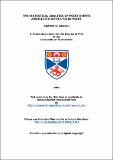Files in this item
The statistical analysis of point events associated with a fixed point
Item metadata
| dc.contributor.advisor | Cormack, R. M. (Richard Melville) | |
| dc.contributor.author | Lawson, Andrew B. | |
| dc.coverage.spatial | 573 p. | en_US |
| dc.date.accessioned | 2015-08-21T08:56:39Z | |
| dc.date.available | 2015-08-21T08:56:39Z | |
| dc.date.issued | 1991 | |
| dc.identifier | uk.bl.ethos.316656 | |
| dc.identifier.uri | https://hdl.handle.net/10023/7294 | |
| dc.description.abstract | This work concerns the analysis of point events which are distributed on a planar region and are thought to be related to a fixed point. Data examples are considered from Epidemiology, where morbidity events are thought to be related to a pollution source, and Ecology and Geology where events associated with a central point are to be modelled. We have developed a variety of Heterogeneous Poisson Process (HEPP) models for the above examples. In particular, I have developed interaction and 8-dependence models for angular-linear correlation, with their ML estimation and associated score/W aId tests. In the Epidemiological case we have developed case-control models and tests. The possibility of second-order effects being important has also led to the development of Bayesian Spatial Prior (BSP) models. In addition, we have developed a new deviance residual for HEPP models and explored the use of GLIM for modelling purposes. A variety of results were found in data analysis. In some cases HEPP models provide adequate descriptions of the process. In others, BSP models yield better fits. In general, the discrete case admits a simple spatial Poisson model for counts and does not require BSP model extensions. | en_US |
| dc.language.iso | en | en_US |
| dc.publisher | University of St Andrews | en |
| dc.title | The statistical analysis of point events associated with a fixed point | en_US |
| dc.type | Thesis | en_US |
| dc.type.qualificationlevel | Doctoral | en_US |
| dc.type.qualificationname | PhD Doctor of Philosophy | en_US |
| dc.publisher.institution | The University of St Andrews | en_US |
This item appears in the following Collection(s)
Items in the St Andrews Research Repository are protected by copyright, with all rights reserved, unless otherwise indicated.

